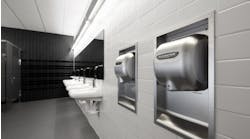School shootings and terrorist attacks have brought the topic of security to the forefront of the national education agenda. Administrators are asking, “What can we do to make education institutions safer, and are we doing all that we can?”
For most institutions, providing a safe environment in which students can learn involves taking pro-active measures to ensure those entering learning zones are welcome and have a valid reason to be on the property.
Education institutions protect their schools in different ways. The Eastchester Union Free School District in Westchester, N.Y., has 2,800 students. Its security system is an IP system that runs on the district's network. Principals and superintendents can monitor security cameras at any location by logging into the network from personal computers, says Anita Better, director of information technology and adult education.
The district recently has added adult-education courses and is installing exterior perimeter cameras to address increased security concerns.
“If there is anybody intending to do any vandalism, they're going to think twice once they have seen the cameras,” says Better.
Montgomery County Public Schools, Rockville, Md., has about 140,000 students. The district has to protect its buildings, including more than 700 portable classrooms, while allowing access for students traveling between the portables and the main building, says Jack Crowley, who was project/training coordinator for the district until recently.
The district uses a proximity lock system in elementary schools that have portable classrooms. Students who need to leave a portable classroom get a card from the teacher and pass it in front of a proximity lock to open the door. Once students pass through the door, it locks again.
In some newer buildings, visitors must check in at the entrance.
“They come into one area, and they have to get an OK from inside in order to proceed farther into the school,” says Crowley.
Access control for higher education institutions often must accommodate more buildings and more students.
At a vast campus such as Ohio State University, Columbus, it's unfeasible to secure the perimeter the way a small campus might, such as using gates to close off all but the main entrance.
“We're such a large beast that geographically and physically, that's not possible,” says Patrick Maughan, director of security and fire-prevention services.
The university uses signage, lighting and pavers to lead students to a common main entrance; it locks back doors and side entrances after hours.
It also uses various hardware devices to secure buildings. A one-card system, the Buck ID, gives access to the library and residence halls, and can be programmed to give students different degrees of access. Law students may have access to areas that would be off-limits to non-law students.
The areas to which students need access most frequently are operated by way of a central database. Administrators can lock and unlock doors remotely from a couple of different locations, says Maughan.
Standalone systems in lesser used buildings allow some departments to manage access control themselves.
The university is upgrading to replace the workstations and hardware from its past standardized platform.
“Rather than just relying on sending the alarm signals or the card-access signals over the old pathway of basically abandoned phone lines, we're now sending them over a TCPIP platform — a secure link on our Internet,” says Maughan.
By improving the way alarm signals are transmitted, the university can monitor locations at other campuses in its system. From Columbus, the staff can monitor the fire-alarm system at a residence hall in Wooster, Ohio, about 150 miles away. The university eventually will be able to monitor all facilities on its regional campuses, says Maughan.
Hall, associate editor, can be reached at [email protected].
NOTABLE
78%
Percentage of residence halls, completed in 2004, with electronic security systems.
Source: American School & University's 16th Annual Residence Hall Construction Report, June 2005.
Sidebar: Looking to the future
With a student population of about 50,000, Ohio State University, Columbus, is considering several innovative ways to approach access control in the future. The university hopes to link key alarms with existing video systems and further investigate the use of biometrics now that prices have come down and the systems have become more user friendly, says Patrick Maughan, director of security and fire-prevention services.
The university also is considering smart video surveillance in the future, in which behavior-based algorithms are written and embedded into surveillance software. The software is able to detect and send an alarm when the scenario deviates from the normal activity pattern for that area.
For example, if a camera is watching a wide view of a parking lot, the software would have several scenarios that the cameras are programmed to look for, such as a person falling to the ground or being chased. If the camera picks up images of students walking to their cars, that is considered a normal activity for that area, so the person watching the camera will know that nothing out of the ordinary is happening and that it doesn't demand full attention. If a person in one of the images was walking and falls to the ground suddenly, the software tells the camera that the normal pattern has been broken and that the event is unusual. A notification is sent to the operator to let them know there might be an incident in the area.
“As that technology improves, I see some value in being able to add that to some areas that are just plain hard to watch, like parking lots,” says Maughan. “You can stare at one all day and not see something going on.”

